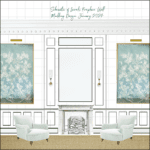Hi Guys,
I guess you know by now that I have moved to the Back Bay neighborhood in Boston. But, what you may not know is how Back Bay got its name.
If we look at a map of Boston today, we can see the neighborhood of Back Bay. The northern border is the mouth of the Charles River.

The residential areas are filled with historical brownstones. Walking around the streets is a dream come true.
However, back in 1630, when Boston was first settled, there was no land here; only water.
Indeed, I now live in the middle of what was once a body of water; a bay. To differentiate it from the larger bay to the east of the tiny Shawmut peninsula (Boston), they called it the back bay; the back bay of Boston Harbor. I mean Bahstan Hahbah. ;]
Even though the bay is now filled in with land (dirt), and yes, garbage, gravel, etc., it is still known as the Back Bay neighborhood of Boston.

Above is a map of how Boston looked in 1630.
In fact, Boston grew from a tiny city of only 800 acres into what it is now, a large city 40 times that size. However, as large cities go, Boston is the second smallest in 48.4 square miles. The smallest town in terms of area is San Francisco, at 47 square miles.

What I find fascinating is that the school district I lived in, where my sons were raised, the Katonah-Lewisboro School District is 55 square miles. (see the blue dark blue area in the upper right corner of the map.) One school district! That’s just how to spread out the population is up in northern Westchester County in New York.
Of course, most large cities grow in size. That is if they have somewhere to grow.
So, how did this all come to pass?
A brief history.
Boston is a historical city and a keystone to the beginning of the American Revolution.

Boston Tea Party, 11×16.5 in, Watercolor, Written by Nathaniel Philbrick and Illustrated by Wendell Minor
Boston, famous for its large natural harbor where incensed Americans dumped massive quantities of tea, had nowhere to grow. That is unless they created more land where there was currently water.
And, after the end of the American Revolution with the young country now separate from Great Britain’s rule, that is what began to happen in the early 1800s.
With the industrial revolution, ambitious Bostonians, coupled with commerce, and a burgeoning population, the well-heeled were running out of space to live.
And, so beginning in the early 1800s, Massachusetts’ capital city began creating land by creating dams and filling in the bay with thousands of acres of new land. They started with the pinhead Shawmut peninsula.

The above map shows the original city in 1630 in dark green. The light green areas are the filled-in parts.
The filling-in continued in the south end and then in the back bay, which wasn’t entirely filled in until 1900. My house was began construction in 1879 and it was finished in 1880.
Where did the land come from?
A lot of it was taken from the surrounding hills, such as Beacon Hill, which was far higher today. That land was used to create the western third of Beacon Hill known as “the Flat.” You may recall my photos from the flat and surrounding areas from about a month ago.
Below is an image I took while on a walk through Beacon Hill last week.
![]()
It doesn’t get any more classic than this Georgian-style beautiful red door with red brick. That definitely looks to be Benjamin Moore Heritage red. It’s the perfect “red door” red. For more beautiful front door colors, please check out this post.
Some of the dirt was brought in by rail cars from neighboring towns.

The above shows the Back Bay, which was also called the “receiving station.” But it became quite a cesspool and source of the stench. Can you imagine? It was believed that these foul smells lead to disease. And, in 1853, the filling in of Back Bay began.

Above is a partial view of Back Bay beautifully rendered by F Fuchs in 1870. At the top of the drawing is the public garden. You can see the Commonwealth Ave Mall. My building is in an empty lot here.
I’ve done a lot of reading and will link to some exciting articles where you can see more maps, photos and read more about this fascinating history.
One thing that I’ve read repeatedly is that there are problems with the artificial landfill in terms of the water table.
Actually, the problems occur when the water table goes too low as the pilings that are the foundation for the land begin to rot. Conversely, the back bay is in a flood zone. It’s a complex issue as engineers are working for long-term solutions.
This is a superb blog post with some interesting info about the neck of the original Boston, which would be totally submerged during times of high tide!

I’m bringing down that map of old and new Boston, again. That huge swath of land above what was Governor’s island is where Logan International Airport is. That’s a lot of landfill.
I’m closing with one more excellent blog post I discovered.
An excellent short video sums everything up very nicely about creating Boston’s Back Bay.

Please note. There will be a quiz on Sunday.
No worries. It’ll be an open-book test. ;]
I hope you enjoyed learning a bit more about this beautiful city I’m living in and some of its rich but sometimes smelly history.
If you’d like to learn more about the houses of Back Bay, there is a fantastic blog called BackBayHouses. And, indeed, it chronicles every building on all 13 streets. The blog tells the history of each home from its inception to the end of the 20th century.
xo,

PS: Please check out the newly updated HOT SALES!
Related Posts
 The Most Exquisite Gardens and Landscaping Ever!
The Most Exquisite Gardens and Landscaping Ever! Don’t Take Away Our Ceiling Fans – We Need Them!
Don’t Take Away Our Ceiling Fans – We Need Them! The Color Orange – Love it, or Hate it?
The Color Orange – Love it, or Hate it? I’m Afraid Our New Rustic Home Will Be Depressing!
I’m Afraid Our New Rustic Home Will Be Depressing! Impressive Decorating On A Shoestring Budget – Only 1,100.00 bucks!
Impressive Decorating On A Shoestring Budget – Only 1,100.00 bucks! My Kitchen Light Fixtures Are Driving Me Bonkers
My Kitchen Light Fixtures Are Driving Me Bonkers Come See the Plans for My New Living Room Wainscoting!
Come See the Plans for My New Living Room Wainscoting!

















